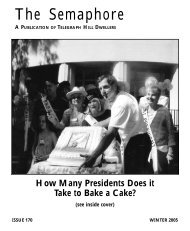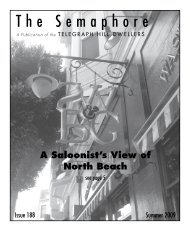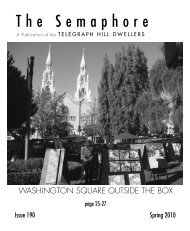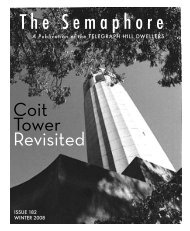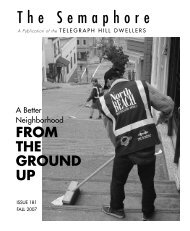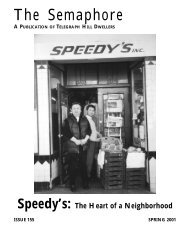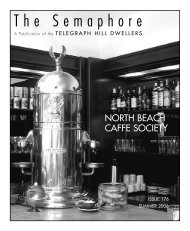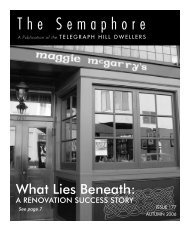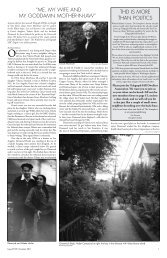Issue 183, Spring 2008 - Telegraph Hill Dwellers
Issue 183, Spring 2008 - Telegraph Hill Dwellers
Issue 183, Spring 2008 - Telegraph Hill Dwellers
- No tags were found...
Create successful ePaper yourself
Turn your PDF publications into a flip-book with our unique Google optimized e-Paper software.
A Port Primer <strong>2008</strong> continued from page 29pays a lease fee to the Port Commission, and thenew development generates tax revenue. The PortCommission uses the lease payments and the estimatedtax receipt increment to issue a bond, whichin turn pays for the development of projects such asthe new cruise ship terminal.And that’s where the fun begins. If only finding areasonable compromise between the scope of waterfrontdevelopment projects and sufficient revenuegeneration for the Port Commission were as easyas finding a fleece for under $10.00 on Fisherman’sWharf.The development of Piers 27-31 has a long andcontroversial history dating back to the turn of thecentury (not the one with the Gold Rush; the oneThe Pagoda continued from page 28In 1994, facing competition from video andbecause of decreased attendance following a gangshooting in the theater, the Pagoda Palace closed forgood.The End of the EndLater that year, Lam Kin Ming a Hong Kongreal estate developer and garment manufacturerbought the building for a purported two million dollars.In preparation for building a shopping center,the new owner gutted the building of its art decoaccoutrements, including its ticket booth and thecurving staircase. A number of design plans weresubmitted in the following years—at least one ofwhich was approved by the neighbors—but no developmentmaterialized.Then in 1997 the infamous Rite-Aid controversyerupted. This was a time that drug stores and bankswere looking for a home on every corner. The drugstore corporation Rite-Aid was particularity interestedin San Francisco. By 1997, they have established 7with Starbucks and Apple Computers). This historyhas been covered through the years by the Semaphore,so I won’t bore you with the details, other than to saythat the previous developer, the Mills Corporation,crashed and burned after strong opposition to itsplans and manners, and it sold its development rightsto the hometown duo of Shorenstein Properties andFarallon Capital Management.The Shorenstein group took over the remainderof Mills’s exclusive right to negotiate (ERN)for Piers 27-31 in early 2006. Sixty plans, 100 proformas, and several extensions of the ERN later, andthe Shorenstein group is on the verge of presentingits latest plans for the piers before the current ERNexpires on May 31, <strong>2008</strong>.continued on page 38SF locations and had plans for twenty more. One ofthese was to be a twenty four hour pharmacy on thesite of the Pagoda. The neighborhood erupted in displeasure.At a community meeting—with the exceptionof neighborhood gadfly Richard Hanlin—therewas universal opposition. The community rented abill board to publicize its message “Rite/Aid/WrongPlace” and Rite Aid gave up its quest for the Pagoda.Although even in the end the company didn’t seemto get it. A Rite Aid spokesperson commented onthe company’s automated prescription dispensingmachines; “Our new state of the art system makes thepharmacy almost like a factory. It’s almost like a conveyerbelt.” Conveyer belts in North Beach? What’swrong with that picture?So Rite Aid went away, but the saga of thePagoda continues. More in our next issue.June Osterberg’s North Beach Beat stories“Theater on the Square” and “When the CockettesPlayed the Palace, “ provided valuable informationfor this piece.30 <strong>Issue</strong> #<strong>183</strong> • <strong>Spring</strong> <strong>2008</strong>




